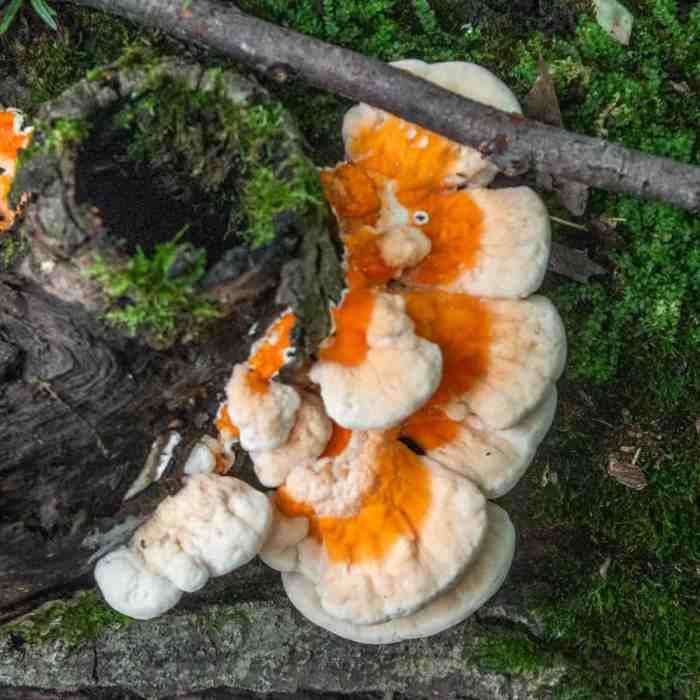
Welcome to the fascinating world of chicken of the woods! This vibrant mushroom, boasting an uncanny resemblance to a chicken’s plumage, is not just a sight to behold but also a culinary treasure. Dive into our chicken of the woods recipe guide to discover the secrets of preparing this delectable forest delicacy.
From sautéing to grilling, we’ll take you through various cooking methods that unlock the mushroom’s umami-rich, earthy flavors. Whether you’re a seasoned chef or a kitchen novice, our step-by-step instructions will guide you towards creating mouthwatering dishes that will impress your taste buds.
Introduction to Chicken of the Woods

Chicken of the woods (Laetiporus sulphureus) is a large, bright orange mushroom that is common in North America and Europe. It is a polypore mushroom, meaning that it has pores on the underside of its cap instead of gills. Chicken of the woods is a popular edible mushroom, and it is often used in soups, stews, and stir-fries.
Chicken of the woods is a versatile mushroom that can be cooked in a variety of ways. It can be fried, roasted, grilled, or sautéed. It has a mild, slightly nutty flavor that pairs well with a variety of dishes.
Historical Uses, Chicken of the woods recipe
Chicken of the woods has a long history of use as a food source. It was first documented in Europe in the 16th century, and it was brought to North America by European settlers in the 18th century. Chicken of the woods was a popular food source for Native Americans, and it is still used in traditional dishes today.
Cooking Methods for Chicken of the Woods
Chicken of the woods is a versatile mushroom that can be cooked in various ways to bring out its unique flavors. Here are some common cooking methods and step-by-step instructions to help you prepare this delicious delicacy:
Sautéing
Sautéing is a quick and easy method that allows you to retain the vibrant colors and textures of chicken of the woods. Heat a skillet over medium heat, add some oil or butter, and cook the mushroom slices for 5-7 minutes until golden brown.
Season with salt and pepper to taste.
Roasting
Roasting is an excellent method for bringing out the earthy flavors of chicken of the woods. Preheat your oven to 400°F (200°C). Toss the mushroom slices with olive oil, salt, and pepper, then spread them on a baking sheet. Roast for 15-20 minutes or until tender and slightly caramelized.
Grilling
Grilling is a great way to impart a smoky flavor to chicken of the woods. Preheat your grill to medium-high heat. Brush the mushroom slices with olive oil and season with salt and pepper. Grill for 3-4 minutes per side or until tender and grill marks appear.
Frying
Frying is a popular method for creating crispy and flavorful chicken of the woods. Heat a deep fryer or a large skillet filled with oil to 375°F (190°C). Dip the mushroom slices in a batter of your choice and fry for 2-3 minutes or until golden brown and crispy.
For those of you who live in the Bay Area, the chicken of the woods recipe is a must-try. This local delicacy is found in abundance during the fall months. So if you’re looking for a unique and delicious meal, be sure to give this recipe a try.
Flavor Profiles and Pairing Suggestions: Chicken Of The Woods Recipe

Chicken of the woods boasts a unique flavor profile characterized by its umami-rich and earthy notes. Its meaty texture and subtle sweetness make it an excellent culinary ingredient that complements various dishes.
To enhance the flavor of chicken of the woods, consider pairing it with ingredients that complement its umami and earthy characteristics. Aromatic herbs such as thyme, rosemary, and sage add depth and warmth to the mushroom. Spices like garlic, onion, and paprika provide a savory base that complements the mushroom’s natural flavors.
Chicken of the woods is a type of mushroom that is found in North America and Europe. It is a popular edible mushroom, and it can be cooked in a variety of ways. One popular way to cook chicken of the woods is to sauté it in butter or oil.
This recipe for chicken of the woods is simple and easy to follow, and it results in a delicious and flavorful dish.
Additionally, a splash of lemon juice or vinegar can brighten the dish and balance its richness.
Suggested Pairings
- Grilled or Roasted:Chicken of the woods pairs well with grilled or roasted vegetables such as zucchini, bell peppers, and onions. A drizzle of olive oil and a sprinkle of herbs enhance the flavors of both the mushroom and vegetables.
- Soups and Stews:The earthy flavor of chicken of the woods adds depth to soups and stews. Its meaty texture holds up well during cooking, making it an excellent addition to hearty dishes.
- Stir-fries:Chicken of the woods can be added to stir-fries for a boost of umami and texture. Its ability to absorb sauces makes it a versatile ingredient in various Asian-inspired dishes.
- Salads:Raw or cooked chicken of the woods can be added to salads for a meaty and earthy component. Its umami flavor pairs well with bitter greens like arugula and dandelion.
- Pasta Dishes:Chicken of the woods can be sautéed and added to pasta dishes for a flavorful and satisfying meal. Its meaty texture and earthy flavor complement creamy sauces and hearty pasta varieties.
Health Benefits and Nutritional Value

Chicken of the woods is a nutritional powerhouse, boasting an impressive array of vitamins, minerals, and antioxidants. It is an excellent source of protein, containing around 10 grams per cup. This protein is essential for building and repairing tissues, and it helps to keep you feeling full and satisfied.Chicken
If you’re a fan of foraging for wild edibles, you’ll definitely want to check out the chicken of the woods recipe . This fungus has a unique flavor and texture that makes it a great meat substitute. Plus, it’s incredibly easy to prepare.
of the woods is also a good source of fiber, which is important for digestive health and can help to lower cholesterol levels. It contains both soluble and insoluble fiber, which work together to keep your digestive system running smoothly.In
addition to protein and fiber, chicken of the woods is a good source of vitamins and minerals, including vitamin C, potassium, and iron. Vitamin C is an important antioxidant that helps to protect your cells from damage, while potassium is essential for maintaining fluid balance and blood pressure.
Iron is necessary for carrying oxygen throughout the body.
Potential Health Benefits
Consuming chicken of the woods may be associated with several potential health benefits, including:
- Immune system support:Chicken of the woods contains several compounds that have been shown to support the immune system. These compounds include polysaccharides, which are complex sugars that have been shown to activate immune cells and help to fight off infection.
- Antioxidant properties:Chicken of the woods is a good source of antioxidants, which help to protect cells from damage caused by free radicals. Free radicals are unstable molecules that can damage DNA and other cell components, leading to chronic diseases such as cancer and heart disease.
- Anti-inflammatory properties:Chicken of the woods contains compounds that have been shown to have anti-inflammatory properties. Inflammation is a major risk factor for many chronic diseases, including heart disease, stroke, and arthritis.
Overall, chicken of the woods is a nutritious and delicious mushroom that may offer several potential health benefits. If you are looking for a healthy and flavorful way to add more nutrients to your diet, chicken of the woods is a great option.
Foraging and Identification Tips

Chicken of the woods is a highly sought-after mushroom due to its delectable flavor and ease of identification. However, foraging for any wild mushroom requires knowledge and caution. This section provides guidance on how to safely and responsibly forage for chicken of the woods, ensuring a successful and enjoyable experience.
Seasonality and Habitat
Chicken of the woods is a seasonal mushroom that typically fruits in late summer and fall. It favors deciduous trees, particularly oaks, maples, and beeches. Look for it on dead or dying trees, as well as on living trees with wounds or injuries.
Distinguishing Characteristics
Chicken of the woods is characterized by its bright orange to yellow coloration and its shelf-like growth habit. The upper surface of the mushroom is velvety and may have concentric rings or bands. The underside is covered with small, white to cream-colored pores.
Safe Foraging Practices
- Always consult with a qualified mushroom expert before consuming any wild mushrooms.
- Never forage for mushrooms in areas that have been treated with pesticides or herbicides.
- Carry a field guide and use online resources to help with identification.
- Take only what you need and leave plenty for others.
- Respect the environment and avoid damaging the trees or surrounding habitat.
End of Discussion

As we bid farewell to our chicken of the woods recipe exploration, remember that this extraordinary mushroom offers not only culinary delights but also potential health benefits. Its nutritional value and antioxidant properties make it a valuable addition to any healthy diet.
So, venture into the woods, forage responsibly, and savor the unique flavors of this culinary gem.
Essential FAQs
What are the best ways to cook chicken of the woods?
Sautéing, roasting, grilling, and frying are all excellent methods for cooking chicken of the woods.
What does chicken of the woods taste like?
It has a unique umami-rich, earthy flavor that complements various dishes and cuisines.
Is chicken of the woods safe to eat?
Yes, chicken of the woods is edible and safe to consume when cooked properly.





